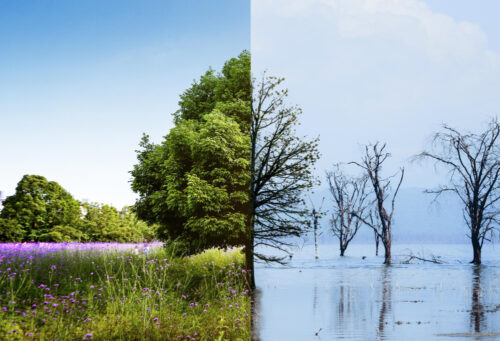Climate change has been one of the most pressing issues of the 21st century, with global temperatures continually rising and the effects being felt worldwide. But when did this problem begin? This article seeks to answer the question – when did climate change start?
Explaining Global Warming
In order to understand when climate change started, it is important to first understand what climate change is. Global warming is the process of an increase in average surface temperatures on Earth due to increasing emissions of greenhouse gases. Greenhouse gases are gases that trap heat and prevent it from escaping into space, thus causing the temperature of Earth’s atmosphere to rise over time.
The most common greenhouse gases are carbon dioxide and methane, both of which have risen considerably over the last few centuries due to human activity, such as burning fossil fuels and cutting down forests. Other activities that affect the amount of greenhouse gases in the atmosphere include agriculture, deforestation and some industrial activities.
The Beginnings of Global Warming
The Earth’s climate has been changing since its formation, and it is estimated that the global average temperature has fluctuated by several degrees over the past few million years. But over the last few centuries, the rate of warming has been much faster than usual, leading some to suggest that human activity is at least partially responsible.
The first written records of climate change date back to the 18th century when French scientist Jean-Pierre Fourier noticed that the Earth seemed to be warming in certain areas. He theorized that this was due to the buildup of greenhouse gases in the atmosphere, though he was not able to explain why or how.
Evidence of Human-Influenced Climate Change
The Industrial Revolution, which began in the late 1700s, saw an increase in the use of coal and other fossil fuels, as well as increased deforestation, leading to an increase in greenhouse gas emissions. In the 19th century, many scientists began to recognize the gradual increase in the Earth’s global temperature, and suggested that this was due to an increase in greenhouse gases.
The evidence for global warming continued to mount in the 20th century as scientists began to study the effects of human activities on the atmosphere. In the 1950s, scientists began to use satellites to measure global temperatures and also track changes in glaciers and ice sheets. By the 1960s, most scientists had accepted that human activities were causing the climate to change, and the concept of global warming had become widespread.
The Paris Agreement
The effects of climate change are becoming more and more evident, with increasingly frequent and intense storms and floods, rising sea levels, melting glaciers and an increase in global temperatures. As a result, in December 2015, 196 countries signed an agreement in Paris to try and limit the global temperature rise to under 2 degrees Celsius by 2030.
The Paris Agreement was the first global commitment to address climate change, and it includes goals such as increasing renewable energy use, reducing deforestation, and increasing energy efficiency. The agreement also sets forth a framework for countries to report their emissions and progress in reducing emissions.
Conclusion
In conclusion, climate change has been a pressing issue for centuries, with increasingly erratic weather, rising sea levels and melting glaciers making it clear that something has to be done to reduce the impact of global warming. It is clear that climate change began in the 17th and 18th centuries, with the Industrial Revolution being the main contributor to an increase in greenhouse gas emissions.
Today, the Paris Agreement is in place to ensure that we reduce global emissions in order to try and limit the global temperature rise. It is now up to us to do our part and ensure that we take the necessary steps to reduce our emissions in order to protect our planet for generations to come.

